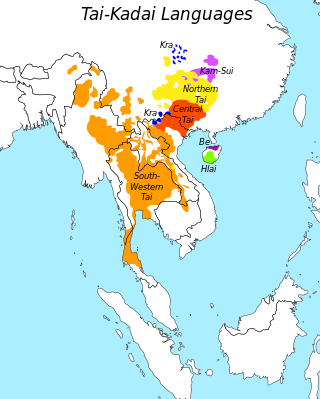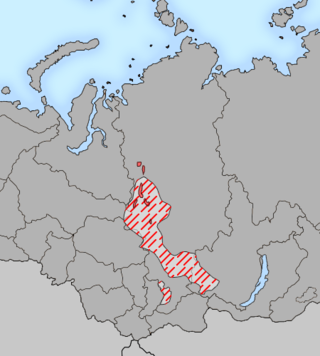
Sino-Tibetan is a family of more than 400 languages, second only to Indo-European in number of native speakers. Around 1.4 billion people speak a Sino-Tibetan language. The vast majority of these are the 1.3 billion native speakers of Sinitic languages. Other Sino-Tibetan languages with large numbers of speakers include Burmese and the Tibetic languages. Four United Nations member states have a Sino-Tibetan language as their main native language. Other languages of the family are spoken in the Himalayas, the Southeast Asian Massif, and the eastern edge of the Tibetan Plateau. Most of these have small speech communities in remote mountain areas, and as such are poorly documented.

The Kra–Dai languages, are a language family in mainland Southeast Asia, southern China, and northeastern India. All languages in the family are tonal, including Thai and Lao, the national languages of Thailand and Laos, respectively. Around 93 million people speak Kra–Dai languages; 60% of those speak Thai. Ethnologue lists 95 languages in the family, with 62 of these being in the Tai branch.
The languages of East Asia belong to several distinct language families, with many common features attributed to interaction. In the Mainland Southeast Asia linguistic area, Chinese varieties and languages of southeast Asia share many areal features, tending to be analytic languages with similar syllable and tone structure. In the 1st millennium AD, Chinese culture came to dominate East Asia, and Classical Chinese was adopted by scholars and ruling classes in Vietnam, Korea, and Japan. As a consequence, there was a massive influx of loanwords from Chinese vocabulary into these and other neighboring Asian languages. The Chinese script was also adapted to write Vietnamese, Korean and Japanese, though in the first two the use of Chinese characters is now restricted to university learning, linguistic or historical study, artistic or decorative works and newspapers, rather than daily usage.

The Yeniseian languages are a family of languages that are spoken by the Yeniseian people in the Yenisei River region of central Siberia. As part of the proposed Dené–Yeniseian language family, the Yeniseian languages have been argued to be part of "the first demonstration of a genealogical link between Old World and New World language families that meets the standards of traditional comparative-historical linguistics". The only surviving language of the group today is Ket.

The Austric languages are a proposed language family that includes the Austronesian languages spoken in Taiwan, Maritime Southeast Asia, the Pacific Islands, and Madagascar, as well as Kra–Dai and Austroasiatic languages spoken in Mainland Southeast Asia and South Asia. A genetic relationship between these language families is seen as plausible by some scholars, but remains unproven.

Vladislav Markovich Illich-Svitych was a Soviet linguist and accentologist. He was a founding father of comparative Nostratic linguistics and the Moscow School of Comparative Linguistics.

Dené–Caucasian is a discredited language family proposal that includes widely-separated language groups spoken in the Northern Hemisphere: Sino-Tibetan languages, Yeniseian languages and Burushaski in Asia; Na-Dené languages in North America; as well as Vasconic languages and North Caucasian languages from Europe.

Sergei Anatolyevich Starostin was a Russian historical linguist and philologist, perhaps best known for his reconstructions of hypothetical proto-languages, including his work on the controversial Altaic theory, the formulation of the Dené–Caucasian hypothesis, and the proposal of a Borean language of still earlier date. None of his proposed macrofamilies have seen wide-scale acceptance in the linguistic community, though his proposals remain influential outside of academia. He was also the author of a widely respected reconstruction of Old Chinese.

Borean is a hypothetical linguistic macrofamily that encompasses almost all language families worldwide except those native to the Americas, Africa, Oceania, and the Andaman Islands. Its supporters propose that the various languages spoken in Eurasia and adjacent regions have a genealogical relationship, and ultimately descend from languages spoken during the Upper Paleolithic in the millennia following the Last Glacial Maximum. The name Borean is based on the Greek βορέας, and means "northern". This reflects the fact that the group is held to include most language families that are native to the northern hemisphere. Two distinct models of Borean exist: that of Harold C. Fleming and that of Sergei Starostin.
Dene–Yeniseian is a proposed language family consisting of the Yeniseian languages of central Siberia and the Na-Dene languages of northwestern North America.

The Austro-Tai languages, sometimes also Austro-Thai languages, are a proposed language family that comprises the Austronesian languages and Kra–Dai languages.
The Soviet Union actively tried to incorporate Marxist ideals into the study of linguistics.
There have been various classification schemes for Southeast Asian languages.
Paul King Benedict was an American anthropologist, mental health professional, and linguist who specialized in languages of East and Southeast Asia. He is well known for his 1942 proposal of the Austro-Tai language family and also his reconstruction of Proto-Sino-Tibetan and Proto-Tibeto-Burman. He was also a practicing psychiatrist in the New York area for 20 years and was also a pioneer in the field of ethnopsychiatry.
The East Asian languages are a language family proposed by Stanley Starosta in 2001. The proposal has since been adopted by George van Driem and others.
Sergei Lvovich Nikolaev is a Russian linguist, specialist in comparative historical linguistics, Slavic accentology and dialectology. He is the author of a number of books and articles on Indo-European studies, accentology, and Slavic dialectology. Nikolaev is a Doctor of Sciences in Philological Sciences.
The Moscow School of Comparative Linguistics is a school of linguistics based in Moscow, Russia that is known for its work in long-range comparative linguistics. Formerly based at Moscow State University, it is currently centered at the RSUH Institute of Linguistics, and also the Institute of Linguistics of the Russian Academy of Sciences in Moscow, Russia.

The Old Yue language is an unattested, unclassified language, or group(s) of various languages, spoken in ancient southern China, and northern Vietnam circa 700 BCE or later. It can refer to Yue, which was spoken in the realm of Yue during the Spring and Autumn period, or to the different languages spoken by the Baiyue. Possible languages spoken by them may have been of Kra–Dai, Hmong–Mien, Austronesian, Austroasiatic and other origins.









